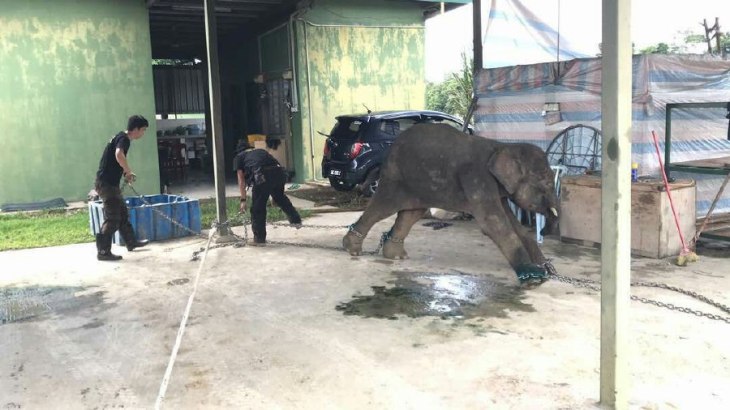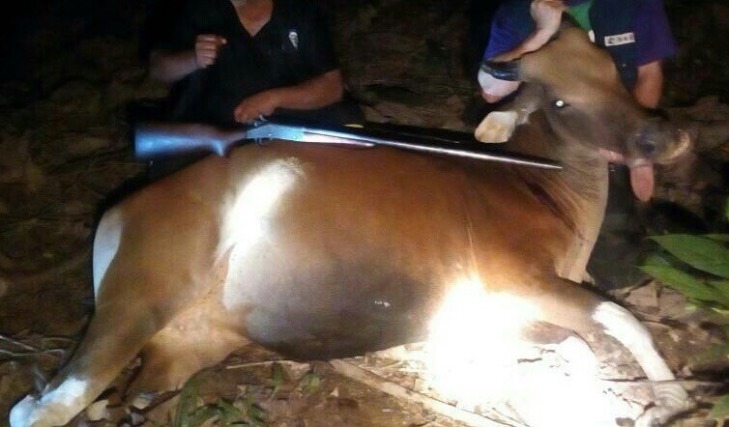One of the more recent cases where a female Banteng was shot by poachers in the vicinity of Maliau Basin last October 2017.
Photo: Danau Girang Field Centre
Malaysia: VIPs, managers among poachers
By Kan Yaw Chong, 1st December 2017;
The future of Sabah’s Banteng (Bos javanicus) or wild cattle has reached a “critical” situation, says Sabah Wildlife Department (SWD) Deputy Director Peter Malin.
“Given an average of four gunned down per month in the State by poachers and Sabah has only an estimated 316 Banteng left, the only fitting words to describe it is we have a critical situation,” he said.
He was speaking at the two-day Bornean Banteng International Workshop and Conference here Thursday, representing SWD Director Augustine Tuuga, where all speakers from across Indonesia, Thailand, Cambodia and Sabah reported a decline of the Banteng populations.
“Sabah is left with no other choice but do something to control and reduce the killings or else the fate of our Banteng will be heading towards the same as our Sumatran Rhino (Dicerorhinus sumatraensis),” said Indra Sunjoto, Deputy Director of the Sabah Forest Department, who spoke on “Challenges of managing Banteng in commercial forests in Sabah.”
All speakers, from Dr Benoit Goossens, Director of Danau Girang Field Centre, to Iman Sapari of Kalimantan, Naris Bhumpakphan of Thailand, Prum Sovana of Cambodia and veteran researcher Ramesh Boonratana, cited poaching as the main culprit behind the decline.
In the course of his research dating back to the past, Boonratana said he found VIPs were among the pack of hunters who were contributing to its possible extinction.
“This fact is hard to take because they are supposed to set an example,” Boonratana noted.
At a press conference, Guest of Honour and Chief Conservator of Forests Datuk Sam Mannan, who launched the workshop earlier, said among the poachers were “people of high ranking in the oil palm industry and managers of plantations.”
“It couldn’t have been anybody else because they have their typical planters’ uniforms – shorts and high socks,” he told reporters.
“You see how difficult and how hard it is, and how embarrassing it is like RSPO,” he added.
“We wrote to RSPO and advised them: You warn your people who are certified and people who are with you that this is happening,” said Mannan, who noted the deteriorating poaching menace even within protected forests has forced the Forestry Department to take a direct role in prosecuting poachers caught in the act in a twin approach with the Wildlife Department to catch and put illegal hunters behind bars.
“We will start first where it will make a difference,” Mannan said
Asked what that meant, he said: “We will go where it all started first – Lahad Datu, Tabin, some parts of Kalabakan, south of Maliau, then the highway in Sapulut down to Tawau, especially the point where you enter Maliau Basin and then smaller cases in the northern area usually done by kampung people and Sipitang, etc.”
On what will make the difference this time around, Mannan said the authorities have mooted the idea of a specialised team of rangers to look solely into wildlife protection aspects, including data and intelligence collection and surveillance analysing and prosecution.
“They will be armed and work on shifts. They don’t do anything but 24-hour surveillance. We will give them guns.
It’s not necessarily to shoot people, more for warnings, but if things get heated, they have to be able to protect themselves,” he said.
“In the past, the same people looked after illegal felling, do forest restoration, do anti-poaching and so on, they were not focused. It doesn’t work but now they are focused, say five people in one vehicle and they do nothing else except go after poachers,” he added.
Mannan said the idea is still at the proposed stage, but added that the elite rangers would be under the Wildlife Enforcement Unit if accepted.
“A better effect sought would be deterrence,” said Boonratana.
Dr Goossens said plans are afoot to vastly improve surveillance, detective, software and hardware to analyse camera trap pictures and information gathered which will be able to pinpoint the whereabouts accurately and send enforcement teams to go to places that are very likely to catch the poachers.
“There is now that willingness to do what it takes such as increase the protection with 50 more forestry rangers who are mobile and focused only on wildlife,” noted Dr Goossens.
“It is very critical that we have a surveillance intelligence gathering, we will provide the training because information gathered need to be analysed so that enforcement teams will be able to go to places that are very likely will catch the poachers. Otherwise, we are sending rangers running around wasting time for nothing,” Goossens said.
Goossens said he agreed urgent work must begin now to avert another disaster like what befell Sabah’s Sumatran Rhino.
“Basically we have increased some of the populations like those in Sipitang, Sugut, etc, which don’t have enough numbers to survive the long term and even if there is no poaching, they go down.
So we need to supplement those populations and a captive breeding programme would be a solution to provide those animals,” Goossens told the media.
“We don’t want to end up with a situation like that of the Rhino where in 20 years we realise we have only 10 individuals left and only then suddenly do a captive program too late,” he explained.
“So with the Banteng, we want to start now and that’s going to be something we want to discuss in the workshop Friday (Nov 31) exactly what is the best way to do it and then together with the support of the Forestry Department, start a programme as soon as possible.”











